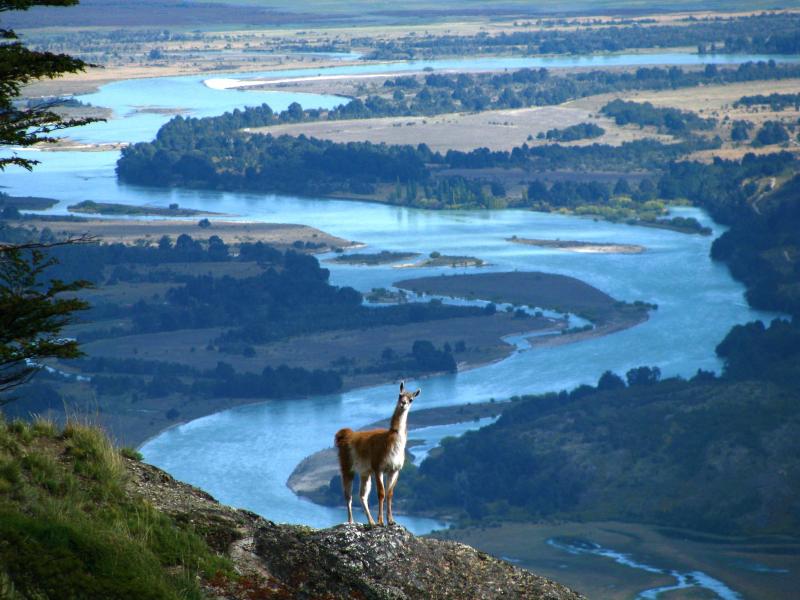
Patagonian Wildlife
By Abi Smith
Patagonia refers to an area in South America containing the countries of Argentina and Chile. The southern section of the Andes mountain ranges can be found here, as can Argentina’s Colorado River.
Patagonian Mara
Patagonian Mara, dolichotis patagonum, live in the desert regions of Argentina. Maras build dens in grasses as the dense vegetation provides cover from predators. They have a rabbit-like appearance but have long hind legs useful for running which allows them to get away from predators more easily. They are prey for animals such as the fox and puma.
Males are slightly larger than females and although they travel together in pairs they have different roles- females spend a lot of time raising offspring and the male will watch for predators. There is only a small window of opportunity in which to breed so usually Patagonian Maras mate for life, with the male staying close to the female to maximise the chances of producing offspring.
Litters usually produce 1-3 offspring, once a year. When the pups are born the Maras may move into large warren settlements and raise them all communally. They move around a lot due to changing food sources as their foraging can exhaust resources very quickly. The Patagonian Mara is a strict herbivore and up to 70% of their diet may be made up of grasses, with a large remainder being cacti.
Chilean Flamingo
These pink birds, phoenicopterus chilensis, inhabit shallow lakes in South America. They are social birds that feed, fly and nest together, and they can often be seen standing around in large groups. When migrating, they form a V-shape and call to one another as geese do. Perhaps the most recognised feature of the flamingo is their standing on one leg- they do this to conserve body heat. Usually, due to the alkaline content of the lakes, there tends to be a lack of vegetation in the areas they dwell.
Chilean Flamingos feed mainly on invertebrates that live in the mud in the ponds they dwell at, including shrimp, molluscs and brine flies. They also eat algae and some aquatic plants. They do not really have many predators, their main threat being humans who may hunt them for their highly prized plumages or simply sport. It is very likely that you will see flamingos if you have organised a trip to an area that contains alkaline lakes.
South American Fur Seal
Residing on rocky coastal shores, the South American Fur Seal, arctocephalus australis, is easy to spot as they are social creatures and gather together in groups. Breeding periods are spent almost entirely ashore, females giving birth to one pup each breeding season. The female will then split her time between foraging for food in the sea and caring for the pup onshore.
The Fur Seal will hunt in groups for fish as well as feeding on shrimp, lobster and krill. They dive up to 170 metres and stay underwater for around 7 minutes. Females caring for young will spend a few days at sea before returning to the pup. Fur Seals are themselves prey for sea lions and sharks, though humans also present quite a threat through hunting, and overfishing limits their food resources.
Weeping Capuchin Monkey
Capuchin Monkeys, cebus olivaceus, are named after an order of friars called the Capuchins who wear robes resembling the patterns of the animals’ fur. The weeping variety are found in South American forests and hunt for food here as well as using the trees to provide protection from predators. Males and females are roughly the same size although males may be slightly heavier.
Foraging patterns can change for the monkeys depending upon perceived threats and changing seasons. Primarily they eat nuts, seeds, fruit, berries and some invertebrates. Coastal species have diets that include oysters and crabs. Capuchin monkeys can easily escape from ground predators and so their biggest threat tends to be humans, who prize them highly and capture them for zoos.
Weeping Capuchins are highly sociable and live in large groups. One dominant male will mate with lots of females in the group, who produce offspring roughly every year and a half.
National Parks can be a good place to visit to spot wildlife, especially if you enlist the aid of a guide who will know where to find any specific animals you have an interest in. Laguna Blanca National Park in the Patagonian region is home to a lagoon with many different types of interesting aquatic birds, and many artefacts of historical significance have also been found around the park, making it a great place to visit even if you don’t see any of the wildlife you intended- some animals can be quite elusive when they wish to be!
Share this article:




















